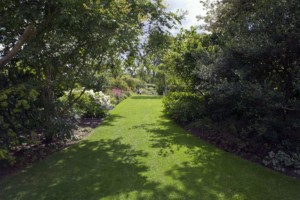Mar
Tips for Growing Arizona Sod in the Shade
Trying to maintain healthy, quality grass in the shade is like fighting an uphill battle where the grass is always greener on the other side. The first step towards overcoming this battle begins with understanding the problems grass encounters in the shade.
The 2 Main Problems Arizona Sod Faces in the Shade:
Problem #1: The lack of both the quality and quantity of sunlight the grass is exposed to in the shade. When grass receives refracted, reflected or filtered light, the quality of the light is much less powerful than when it’s direct. In response to this type of light, the grass will grow different types of leaves that are less durable than leaves grown by grass in direct sunlight. Shaded grass also has a weaker root system, which leaves it more susceptible to water damage and less durable to increased foot traffic.
Problem #2: A reduced exposure to air movement, which can leave the grass wet for longer periods of time. Dew settles on grass naturally overnight and when the grass is in a well-lit area, it will dissolve early in the day causing little to no harm to the grass. Shaded grass on the other hand, stays wet longer, exposing the grass to an increased potential for disease development.
Now that you understand the problems, here are some solutions to help you improve your shaded Arizona sod’s performance:
5 Ways to Help Arizona Sod Grow in the Shade:
- Improve airflow as much as possible to naturally minimize the amount of time that your shaded grass stays wet from morning dew.
- Be cautious when watering to avoid overwatering grass in the shade. A shaded area of grass should never get as much water as an area receiving direct sunlight. Follow these watering guidelines for additional help.
- Fertilize in moderation. Avoid over-fertilizing, but don’t neglect the shaded area altogether. Also, be sure to time your fertilizing accordingly depending on the time of year and weather during that season.
- Try to minimize foot traffic. Grass in shady areas will always be less durable than grass in sunny areas so the less foot traffic the longer your grass will live.
- Resod as needed. It’s common for grass in shaded areas to die after a few years, which will require resodding. This is the natural process of grass living in this type of environment.
In conclusion, the best way to minimize these problems, and maximize these solutions stems from the type of Arizona Sod that you lay in the area. There are a select few species of sod that do better in the shade and others that normally dislike full sun. To ensure that your lawn has the best mix of Arizona sod for both sun and shade, contact the sod experts at West Coast Turf today.


